In this mansion in December 7th, of 1971 the police were called. The reclusive family that lived in this estate had not been seen. Due to their nature, this was not unusual. They weren’t highly social people. The lights remained on all throughout this time, but neighbors began to suspect something was wrong when one after another, the lights burned out.
The police arrived to a dark house that had all the doors locked, and no response from the residents inside. Searching for a way in, an unlocked window was found, and an officer made his way inside.
Icy cold air basted from the air conditioner, and gospel music echoed through the darkness on the intercom system. The house otherwise was still, and stale. An odor hung in the air, as the officers made their way through the nineteen room mansion. When they reached the ballroom, they discovered the source.
Meet John List
And his lovely family;
That is John, his wife Helen, and their children
Patricia List
John List, Jr.
Frederick List
This is Alma List;
John’s mother.
John was an accountant that by all accounts did relatively well. The family appeared to be the picture of the American Dream. They were a close knit, and devoutly religious family of Lutherans, attending church each Sunday. John served as a Sunday school teacher.
John purchased the lavish Victorian home called Breeze Knoll for his family, it was said to be the most expensive house in the neighborhood. John worked at a bank to provide until one day, at age forty-six, he lost his job.
No matter what he tried, he was unable to secure another, and refused steadfastly to accept welfare. His father had instilled in him strict standards of self reliance. When no other jobs panned out, he began a pattern that mimicked his daily schedule of going to work.
He would leave the house at the same time each day, go to the train station, and read the newspaper to pass the time, returning home at night as though nothing were amiss. He couldn’t bear to tell his family of their current predicament, so he began to skim money from his mother’s bank account. As John fell deeper into debt, and further into despair, he arrived at a solution to his problems and took action.
On November ninth, 1971 John List waited for his children to leave for school. He took his 9mm Steyr semi-automatic handgun, and his father’s colt .22 revolver to enact his plan. First, he shot his wife in the kitchen as she was drinking her morning coffee. He then climbed the stairs to the third floor of the house. These were his mother’s quarters. He shot her in her bed. He then waited for the children to arrive home.
Patricia arrived first, followed by Fredrick. Both were shot in the back of the head. John then made himself a sandwich, drove to the bank, emptied his accounts and his mother’s accounts. He made his way to the high school where he watched his eldest son, John Jr., play in a soccer match, bringing him home at the completion of the game.
John Jr. was the only member of the List family that had an opportunity to fight back against his father’s execution, and did so. For his trouble, he was shot multiple times in the chest and face. John Senior kept firing until he was certain that the boy was dead. The next order of business was cleanup.
He collected sleeping bags that were used for Boy Scout excursions with his sons, and laid them out in the ballroom. He brought the bodies, one by one and laid them out on top, save for Alma’s. She was too heavy for John to manage moving. She was found in the hallway outside her apartment. He covered his family members’ faces, and attended to the blood.
He canceled all deliveries, wrote notes to the children’s schools stating that they would be away visiting a sick relative, switched on all the lights, and turned on music that he believed was suitable to issue his family’s souls to heaven, wrote a five page letter to his pastor regarding the murders, and left. He was not seen again for eighteen years.
After, the case grew incredibly cold, and it seemed as though it had no chance of ever being solved. The police department would call the newspapers every year on the anniversary of the deaths and press them to rerun the story in order to keep the case alive. They did this relentlessly until they had another idea.
They contact America’s Most Wanted, and asked them to take the case. The show agreed and undertook a process that would spell the end for John List and his time on the run. They hired this man:
Frank Bender. Frank had a unique set of skills as a autodidact forensic artist and fine artist. He had the ability to do an age progression bust, or reconstruction of a person’s degraded remains to show what they would look like, either as they would appear now, or how they appeared in life. His talents in this case were extraordinary.
This is the John List bust;
This is John List at the time of his arrest;
Here is how close Frank Bender was to perfect;
The resemblance is uncanny. John List was identified as an accountant living in Richmond, VA going by the name Robert Clark. He was arrested at his place of work.
When questioned as to why this was the direction he took things, he first cited the money troubles and job loss as his primary motivation. John also said that he felt his family was pulling away from God, and may leave the church. He was displeased with his daughter’s inclination to go into acting.
He also stated that his wife was an alcoholic, and suffered from tertiary syphilis that she had hidden from John. Helen had contracted the disease during her first marriage, and persuaded John to marry in Maryland, where a blood test wasn’t necessary to obtain a marriage license.
He was convicted of all five murders on April 12th, 1991. He was sentenced to five life terms to be served consecutively. He appealed on the grounds that he suffered PTSD from his military service. The appeal was denied.
John List perished in prison on March first, 2008 due to complications from pneumonia. In the years prior to his death he expressed some remorse for his actions, stating;
“I wish I had never done what I did.”
and;
“I've regretted my action and prayed for forgiveness ever since”
When asked why he didn’t commit suicide himself, he responded that he believed that suicide would be a sin, and he would be barred from Heaven, and that he hoped to reunite with his family one day after he died.
In the end, the massacre could have been entirely avoided. The house, and in fact the very room that John left the remains of his solution to his problems, held within it, or rather above it, his very salvation. The ballroom had a very unique feature, and that was a Tiffany ceiling worth approximately $100,000, or in present day, $600,000. In this aerial image you can see the entire house, including the ballroom’s ceiling;
It is the only known surviving image of it, because of what happened just a year later. In 1972, Breeze Knoll burned.
It was thought to be arson, but no suspects were identified. An interesting end for a terrible story.
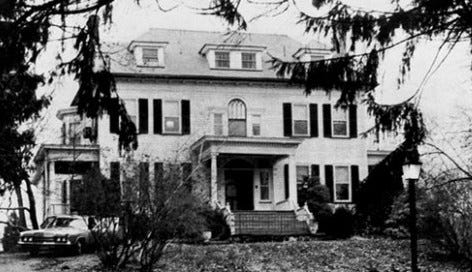



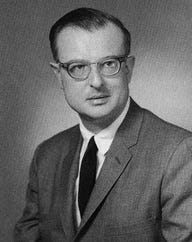
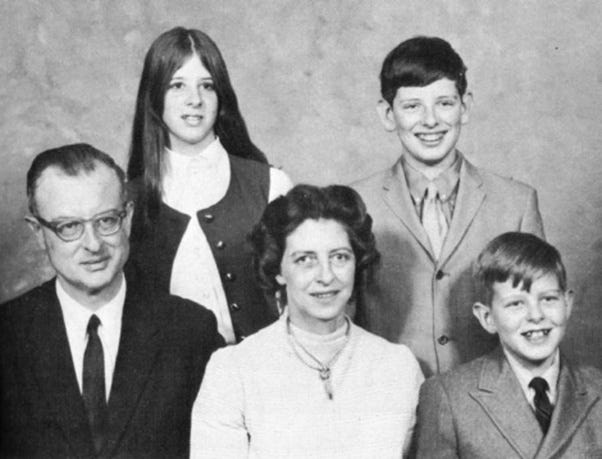
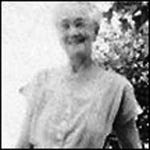
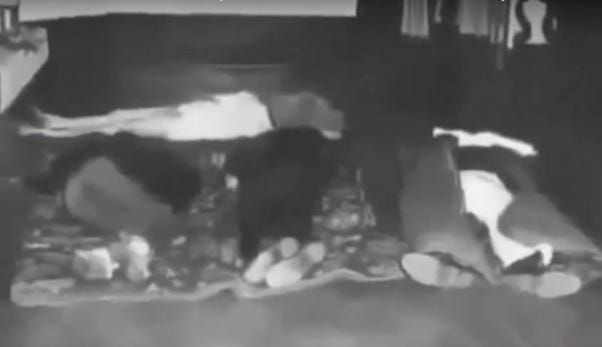


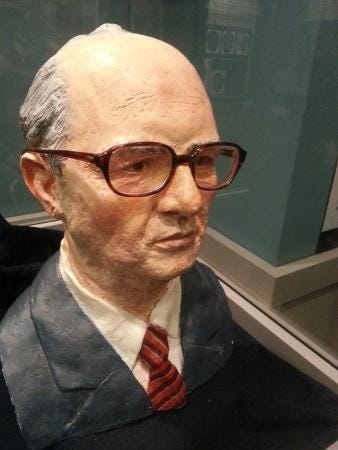
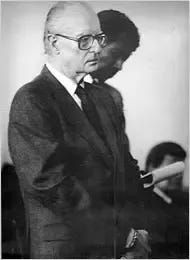
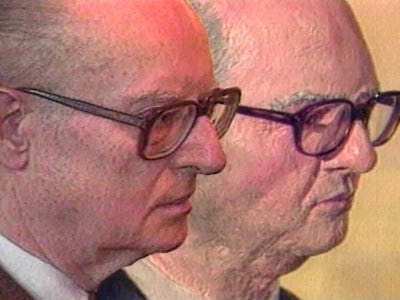
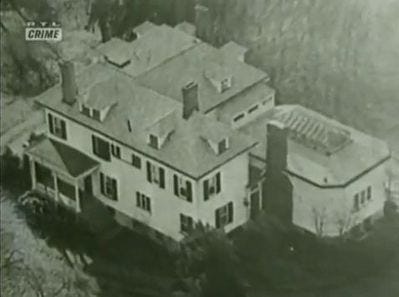
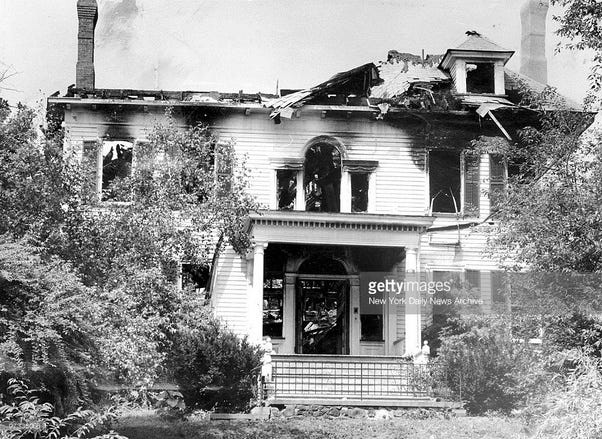
wonder why someone would think murder is the answer to a financial problem. It's like adding gas to the flames. Weird.
List reminds me of William Bishop who also killed his family and has been on the run since 1976.